NISSAN PATHFINDER 2014 R52 / 4.G Consumer Safety Air Bag Information Guide
Manufacturer: NISSAN, Model Year: 2014, Model line: PATHFINDER, Model: NISSAN PATHFINDER 2014 R52 / 4.GPages: 19, PDF Size: 0.45 MB
Page 1 of 19

Table of Contents
Air Bag Protection ________________________________________________1
Child Safety
_____________________________________________________10
Seat Belt Safety
_________________________________________________13
NISSAN’s Customer Care Program
________________________________15
NISSAN’s Commitment to Customer Satisfaction __________________17
2014
NISSAN CONSUMER
SAFETY & AIR BAG
INFORMATION GUIDE
The 2014 NISSAN Consumer Safety & Air Bag Information Guide provides
information for 2014 NISSAN vehicles available at time of publication.
Refer to your vehicles owner’s manual, to familiarize yourself with all disclosures,
warnings, cautions, and all air bag protection and seat belt safety instructions.
This publication may be amended as new vehicles are introduced.
Page 2 of 19
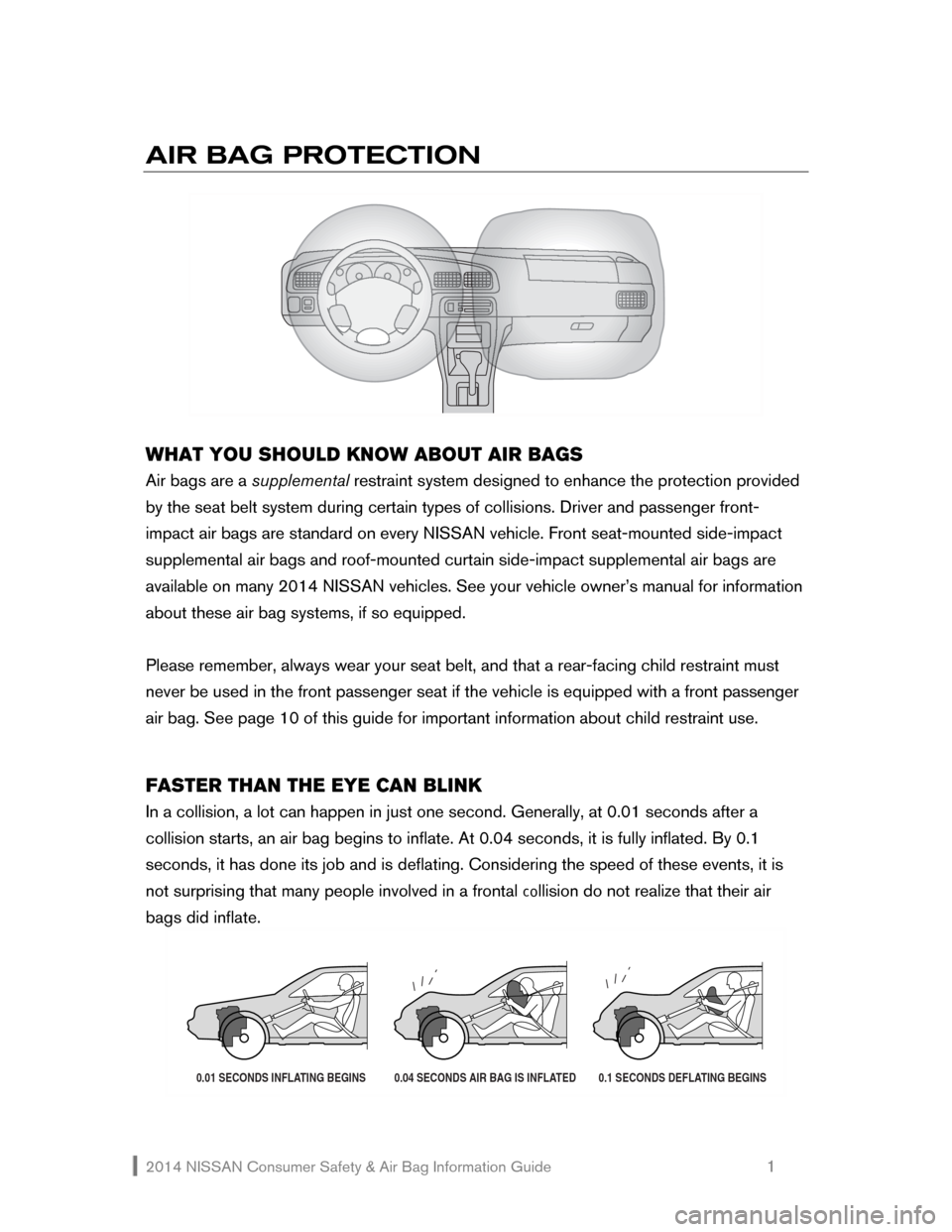
2014 NISSAN Consumer Safety & Air Bag Information Guide 1
AIR BAG PROTECTION
WHAT YOU SHOULD KNOW ABOUT AIR BAGS
Air bags are a supplemental restraint system designed to enhance the protection provided
by the seat belt system during certain types of collisions. Driver and passenger front-
impact air bags are standard on every NISSAN vehicle. Front seat-mounted side-impact
supplemental air bags and roof-mounted curtain side-impact supplemental air bags are
available on many 2014 NISSAN vehicles. See your vehicle owner’s manual for information
about these air bag systems, if so equipped.
Please remember, always wear your seat belt, and that a rear-facing child restraint must
never be used in the front passenger seat if the vehicle is equipped with a front passenger
air bag. See page 10 of this guide for important information about child restraint use.
FASTER THAN THE EYE CAN BLINK
In a collision, a lot can happen in just one second. Generally, at 0.01 seconds after a
collision starts, an air bag begins to inflate. At 0.04 seconds, it is fully inflated. By 0.1
seconds, it has done its job and is deflating. Considering the speed of these events, it is
not surprising that many people involved in a frontal
collision do not realize that their air
bags did inflate.
0.01 SECONDS INFLATING BEGINS 0.04 SECONDS AIR BAG IS INFLATED 0.1 SECONDS DEFLATING BEGINS
Page 3 of 19

2014 NISSAN Consumer Safety & Air Bag Information Guide 2
THE NISSAN ADVANCED AIR BAG SYSTEM
All 2014 NISSAN vehicles (except for the 2014 NV 1500/2500/3500*) are equipped with
the NISSAN Advanced Air Bag System (AABS) for the driver and front passenger seats.
Typically, this system, which has dual-stage inflators,** monitors information from various
crash sensors, the front seat belt buckle sensors, and the occupant classification sensor.
The front passenger air bag may automatically turn OFF under some conditions, depending
on the pressure or weight detected by sensors in the passenger seat. See the vehicle
owner’s manual for more information. If the front passenger air bag is OFF, the front
passenger air bag status light will be illuminated.***
The front passenger air bag status light does not indicate a malfunction of the front
passenger air bag. If the front passenger air bag status light is illuminated while a small
adult, child, or child restraint occupies the seat, the occupant may need to shift his or her
seating position, or remove the child restraint so the system can turn ON the front
passenger air bag and turn off the status light.
THE MOST IMPORTANT PART OF AN AIR BAG: YOUR SEAT BELT
Your chances of surviving a collision will improve greatly if one simple piece of advice is
followed: always wear your seat belt. Remember, all air bags are supplemental restraint
systems. Do not count on just the air bags for occupant protection; they are merely a
supplemental restraint system. You must always use seat belts properly, as explained in
the vehicle owner’s manual.
Seat belts help to protect the occupants of your vehicle during collisions in which the air
bags are not designed to activate. Moreover, in situations where the air bags are activated,
seat belts enhance their effectiveness and can help reduce the risk of injury from an
inflating air bag. Seat belts will also help protect the occupants of your vehicle during
multiple-impact collisions, while the air bags work only one time if a collision is severe
enough to activate them. Please see the SEAT BELT SAFETY and CHILD SAFETY
sections of this guide and the vehicle owner’s manual for more information.
*
The NV lineup is equipped with dual-stage front air bags and seat belt buckle sensors, but the
2014 NV 1500/2500/3500 does not have an occupant classification sensor (and the associated
front passenger air bag status light).
**Dual-stage inflators vary the air bag inflation rate based on the severity of the collision (for
example, less
forceful inflation for moderate impacts and a high force of inflation for more severe impacts). In
addition, based on information from the seat belt buckle sensors that detect whether the seat belts
are fastened, whether one or both front airbags deploy. Only one front air bag may inflate in a
crash, depending on the crash severity, and whether the front occupants are belted or unbelted.
***When the system detects that the seat is unoccupied, the passenger air bag status light will not
illuminate even though the front passenger air bag is OFF.
Page 4 of 19
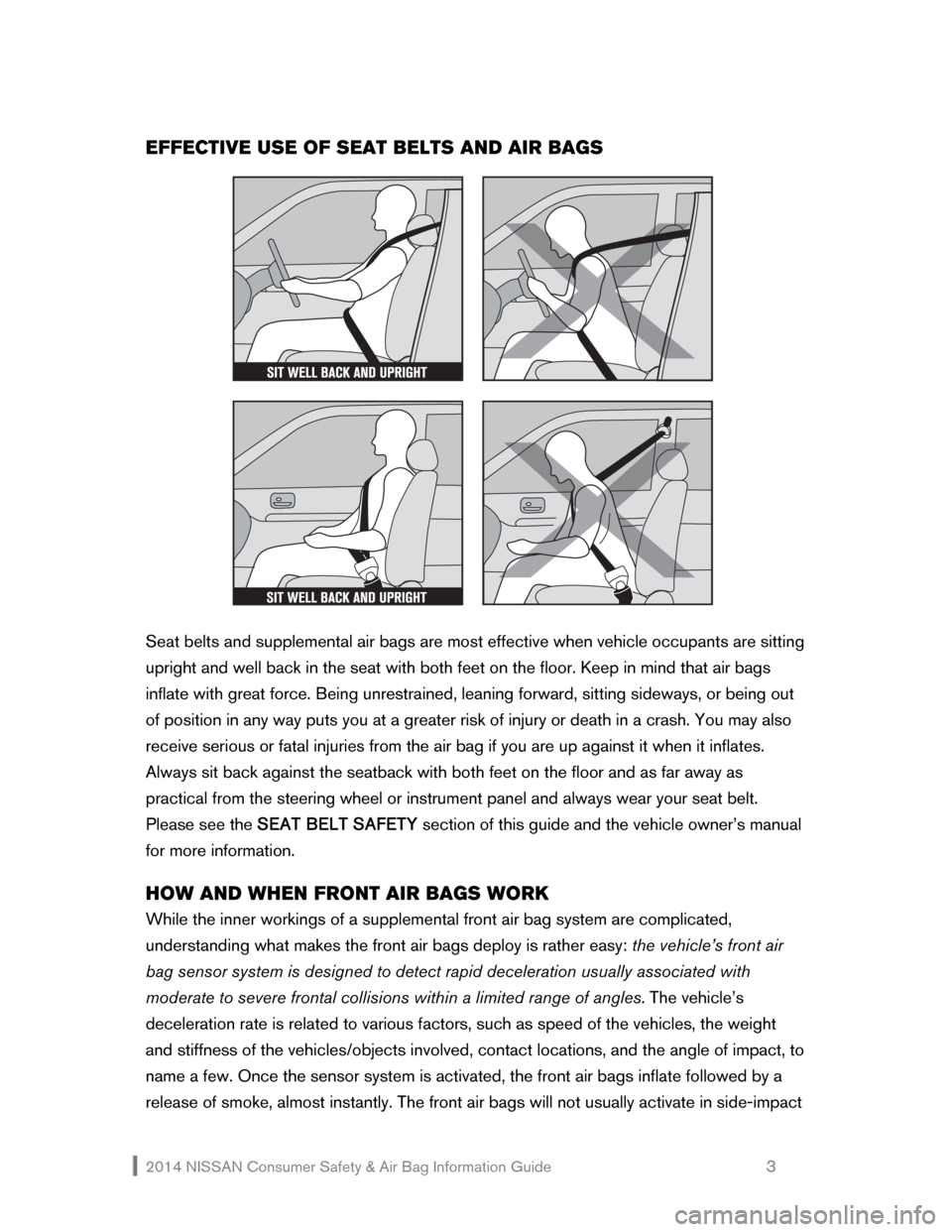
2014 NISSAN Consumer Safety & Air Bag Information Guide 3
EFFECTIVE USE OF SEAT BELTS AND AIR BAGS
Seat belts and supplemental air bags are most effective when vehicle occupants are sitting
upright and well back in the seat with both feet on the floor. Keep in mind that air bags
inflate with great force. Being unrestrained, leaning forward, sitting sideways, or being out
of position in any way puts you at a greater risk of injury or death in a crash. You may also
receive serious or fatal injuries from the air bag if you are up against it when it inflates.
Always sit back against the seatback with both feet on the floor and as far away as
practical from the steering wheel or instrument panel and always wear your seat belt.
Please see the SEAT BELT SAFETY section of this guide and the vehicle owner’s manual
for more information.
HOW AND WHEN FRONT AIR BAGS WORK
While the inner workings of a supplemental front air bag system are complicated,
understanding what makes the front air bags deploy is rather easy: the vehicle’s front air
bag sensor system is designed to detect rapid deceleration usually associated with
moderate to severe frontal collisions within a limited range of angles. The vehicle’s
deceleration rate is related to various factors, such as speed of the vehicles, the weight
and stiffness of the vehicles/objects involved, contact locations, and the angle of impact, to
name a few. Once the sensor system is activated, the front air bags inflate followed by a
release of smoke, almost instantly. The front air bags will not usually activate in side-impact
Page 5 of 19

2014 NISSAN Consumer Safety & Air Bag Information Guide 4
collisions, rear-end collisions, rollovers, while driving on rough roads, or during hard
braking. However, deceleration rates in some situations can be similar to those found in
frontal impacts and may result in front air bag activation.
WHEN THE FRONT AIR BAGS INFLATE
Please remember, for the supplemental front air bags to be most effective, you must always
buckle up and be seated upright and well back in the seat away from the steering wheel or
instrument panel to allow room for the air bags to inflate. For the front air bags to do their
job, they must inflate with great force. As mentioned earlier in this guide, this may cause
serious or even fatal injury if, for example, you are unrestrained out of position in any way,
sitting or leaning too close to the steering wheel or instrument panel during inflation. Even
when seated properly, there is a possibility of injury from an inflating front air bag. This
usually consists of minor skin abrasions or burns, but may be more serious. Overall, these
injuries are minimal compared to the injuries the front air bags are designed to prevent.
After the front air bags have inflated, you may notice a light smoke within the cabin. This is
a normal by-product of the rapid chemical reaction necessary to inflate the front air bags
and, although harmless do not inhale it, it may cause irritation and choking.
REPLACING THE AIR BAGS
Air bags are not reusable. After a collision in which your air bags have activated,
have the respective air bag system inspected and replaced by your NISSAN dealer
as soon as possible. The National Highway Traffic Safety Administration (NHTSA)
has expressed concern regarding reports of counterfeit replacement air bags
installed in vehicles. Visit www.nhtsa.gov
for more information. We recommend the
replacement of air bags by your NISSAN dealer to ensure that you receive new
original equipment replacement parts. Counterfeit replacement air bags may not
be made to the standards of quality, reliability and durability of Genuine NISSAN
parts. The use of counterfeit replacement air bags or used or salvaged air bags is
a potential serious safety problem and may not provide the same level of protection
in a crash.
OTHER SPECIFICS ABOUT AIR BAGS
�ƒ If the air bag warning light continues to remain on or flashes after you start the vehicle,
see your NISSAN dealer as soon as possible.
�ƒ After inflation, air bag components are hot, so avoid contact.
�ƒ Do not place objects on or near the steering wheel or instrument panel where the air
bags inflate.
�ƒ Child restraints for infants must be used in a rear-facing direction and therefore
must not be used in the front seat. Never install a rear-facing child restraint in the
front passenger seat of a vehicle equipped with a front passenger air bag.
�ƒ See the vehicle owner’s manual for other important information.
WELL BACK AND UPRIGHT
Page 6 of 19
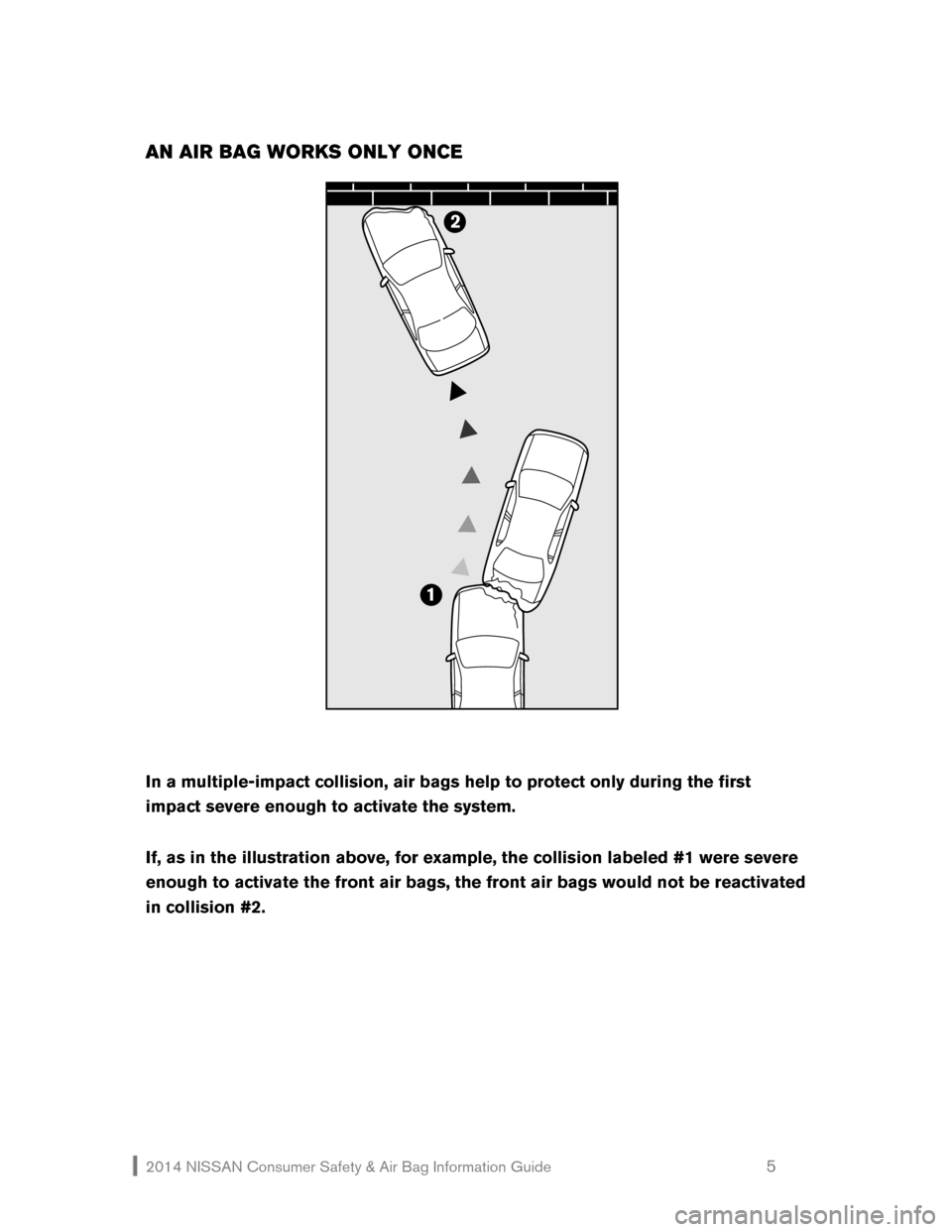
2014 NISSAN Consumer Safety & Air Bag Information Guide 5
AN AIR BAG WORKS ONLY ONCE
2
12
1
In a multiple-impact collision, air bags help to protect only during the first
impact severe enough to activate the system.
If, as in the illustration above, for example, the collision labeled #1 were severe
enough to activate the front air bags, the front air bags would not be reactivated
in collision #2.
Page 7 of 19
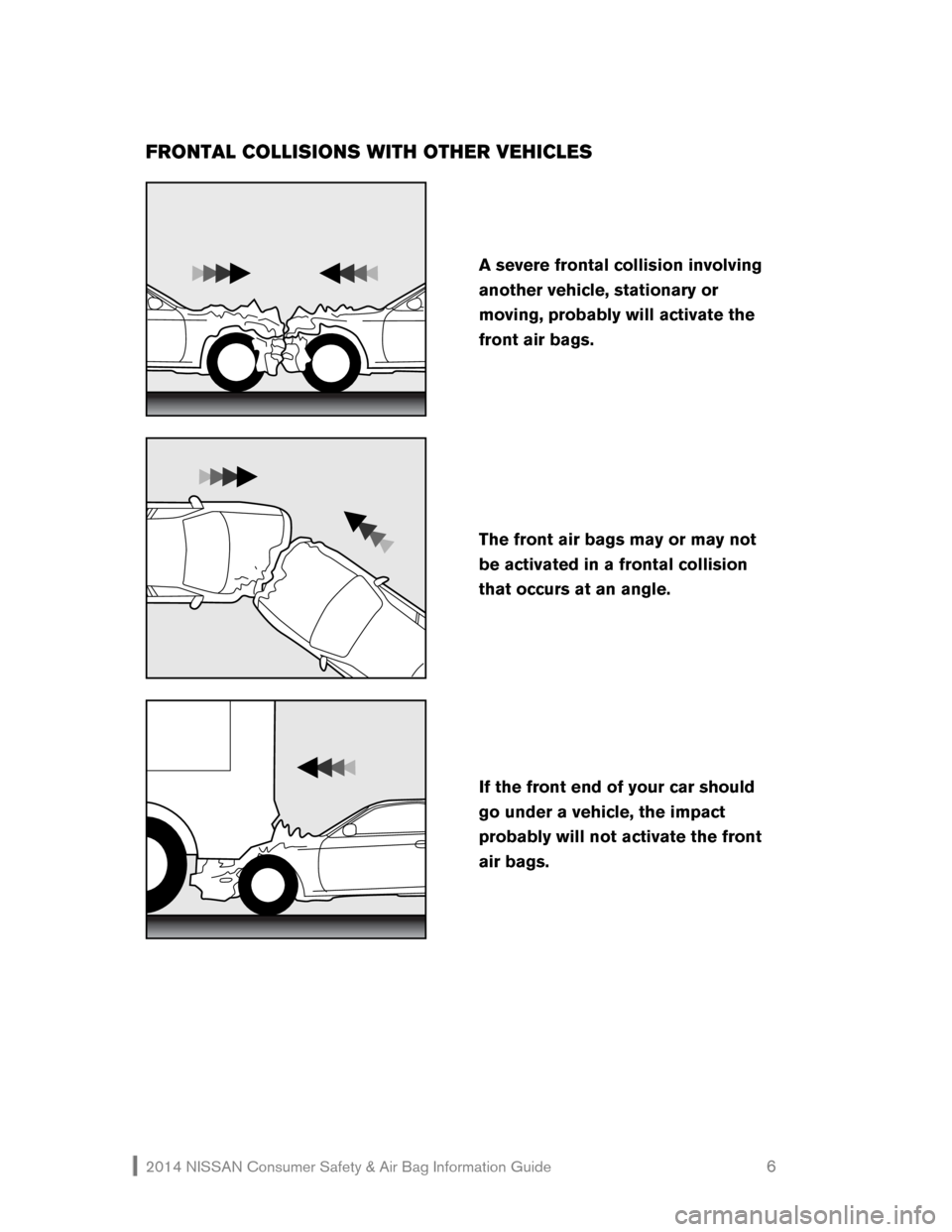
2014 NISSAN Consumer Safety & Air Bag Information Guide 6
FRONTAL COLLISIONS WITH OTHER VEHICLES
If the front end of your car should
go under a vehicle, the impact
probably will not activate the front
air bags.
A severe frontal collision involving
another vehicle, stationary or
moving, probably will activate the
front air bags.
The front air bags may or may not
be activated in a frontal collision
that occurs at an angle.
Page 8 of 19
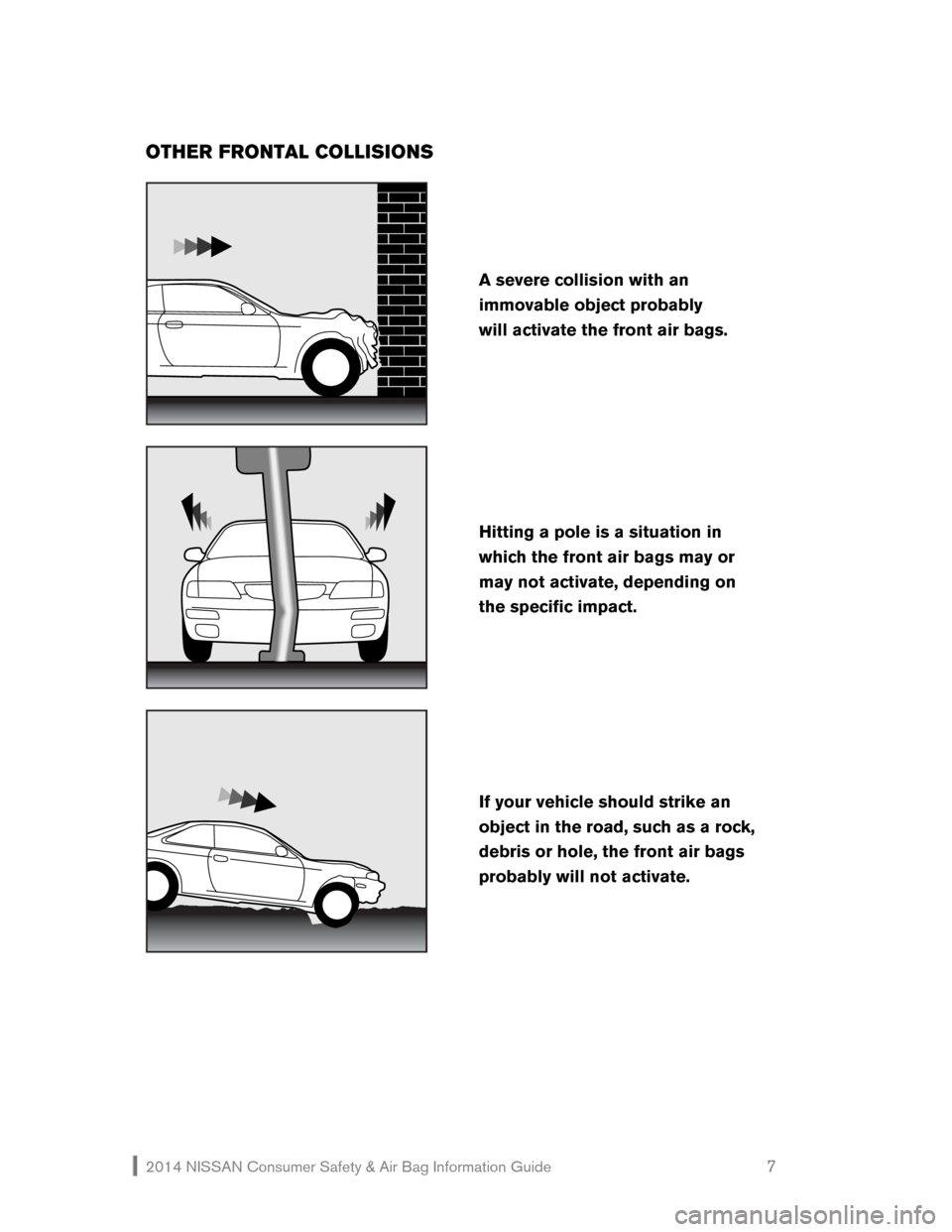
2014 NISSAN Consumer Safety & Air Bag Information Guide 7
OTHER FRONTAL COLLISIONS
If your vehicle should strike an
object in the road, such as a rock,
debris or hole, the front air bags
probably will not activate.
Hitting a pole is a situation in
which the front air bags may or
may not activate, depending on
the specific impact.
A severe collision with an
immovable object probably
will activate the front air bags.
Page 9 of 19

2014 NISSAN Consumer Safety & Air Bag Information Guide 8
SIDE-IMPACT, CURTAIN SIDE-IMPACT, AND CURTAIN SIDE-
IMPACT/ROLLOVER AIR BAG SYSTEMS
Front seat-mounted side-impact supplemental air bags, roof-mounted curtain side-impact
air bags, and curtain side-impact/rollover air bags are available on many 2014 NISSAN
vehicles. Side-impact air bags (if so equipped) are located on the side of the seatbacks of
the front seats. Curtain side-impact air bags (if so equipped) and curtain side-
impact/rollover air bags (if so equipped) are located in the left and right side roof rails or in
the upper part of the front door panels.
Side-impact air bags and curtain side-impact air bags are designed to inflate in higher-
severity side collisions, on the side where the vehicle is impacted. However, they may
inflate if the forces in another type of collision are similar to those of a higher-severity side-
impact. Curtain side-impact/rollover air bags are designed to inflate in certain types of
side-impact collisions and rollovers.
Curtain side-impact air bags and curtain side-impact/rollover air bags are different mainly
in their sensing systems: curtain side-impact air bags are activated primarily in a lateral
collision, whereas curtain side-impact/rollover air bags are activated in either a lateral
collision or a rollover. Since a rollover event lasts longer than a side-impact event, curtain
side-impact/rollover air bags are designed to remain inflated longer than curtain side-
impact air bags.
Side-impact air bags and curtain side-impact air bags, along with the use of seat belts,
help to cushion the impact force on the chest and pelvic area of the front occupants. In
most NISSAN vehicles, curtain side-impact air bags also help to cushion the impact force
to the head of rear outboard-seated occupants. These air bags can help save lives and
reduce serious injury. However, an inflating side-impact air bag, curtain side-impact air
bag, or curtain side-impact/rollover air bag may cause abrasions or other injuries.
Seat belts should be worn correctly and vehicle occupants seated upright. Side impact air
bags, curtain side-impact air bags, and curtain side-impact/rollover air bags inflate quickly
in order to help protect the occupants. The force of an air bag inflating can increase the
risk of injury if the occupant is too close to, or is against these air bag modules during
inflation.
Like front air bags, an inflated side-impact air bag as well as an inflated curtain side-impact
air bag will deflate soon after the collision is over. As noted above, an inflated curtain side-
impact/rollover air bag will remain inflated for a short time afterward. See REPLACING
THE AIR BAGS earlier in this guide.
Page 10 of 19
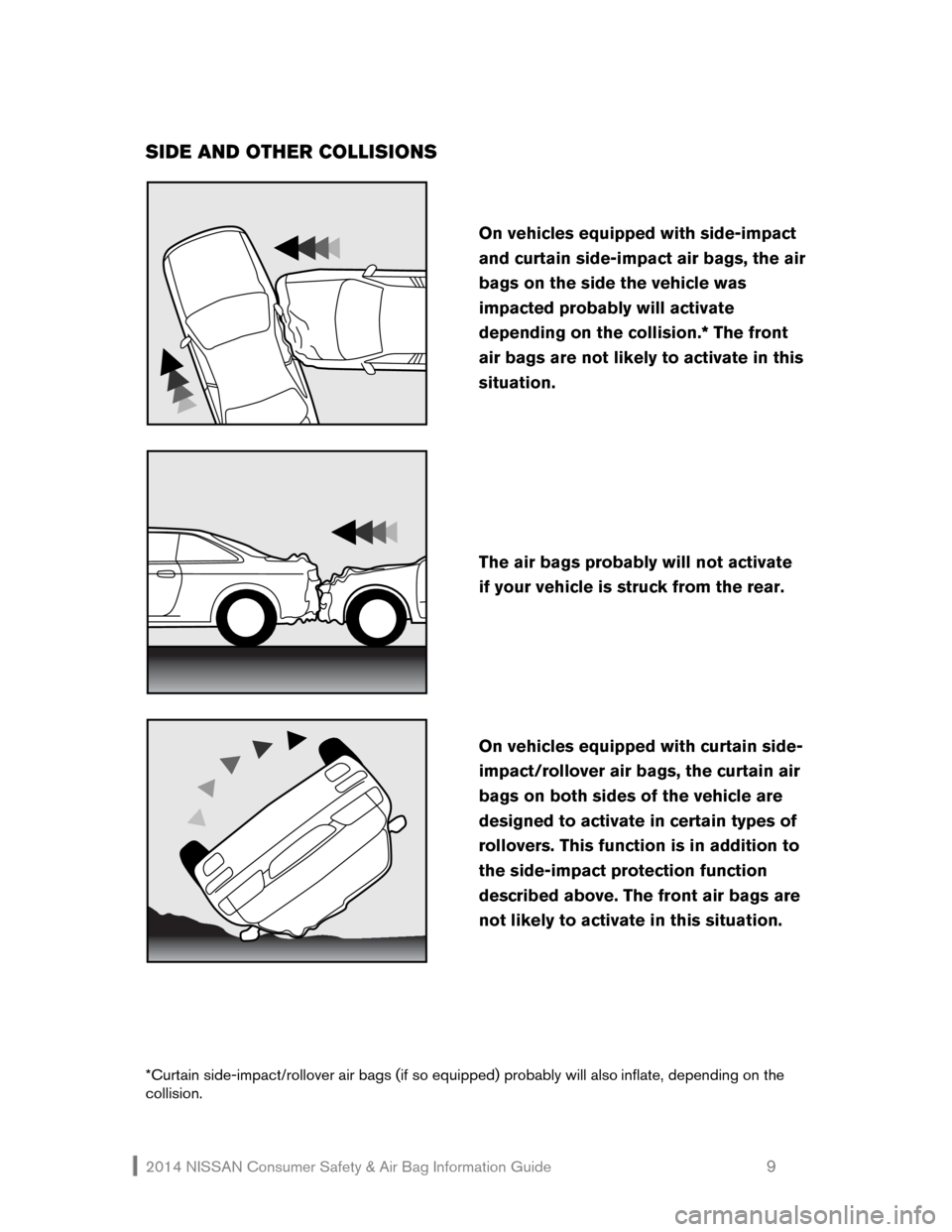
2014 NISSAN Consumer Safety & Air Bag Information Guide 9
SIDE AND OTHER COLLISIONS
*Curtain side-impact/rollover air bags (if so equipped) probably will also inflate, depending on the
collision.
On vehicles equipped with curtain side-
impact/rollover air bags, the curtain air
bags on both sides of the vehicle are
designed to activate in certain types of
rollovers. This function is in addition to
the side-impact protection function
described above. The front air bags are
not likely to activate in this situation.
The air bags probably will not activate
if your vehicle is struck from the rear.
On vehicles equipped with side-impact
and curtain side-impact air bags, the air
bags on the side the vehicle was
impacted probably will activate
depending on the collision.* The front
air bags are not likely to activate in this
situation.